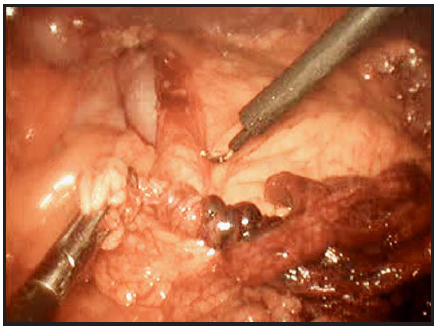Abdomen agudo por torsión de epiplón mayor simulando una apendicitis aguda
Palabras clave:
epiplón mayor, apendicitis, laparoscopiaResumen
La torsión del epiplón mayor es una patología poco frecuente con una clínica inespecífica, por
lo que históricamente su diagnóstico es realizado en el quirófano ya que simula patologías
como la apendicitis o colecistitis. Los métodos auxiliares de diagnóstico como las ecografías
o las tomografías son de mucha utilidad para la sospecha de esta patología, aunque no
cuenta con signos patognomónicos de la enfermedad, las imágenes asociadas a la clínica del
paciente pueden llevar a un diagnóstico preciso. Presentamos el caso de un paciente joven
de sexo masculino, que acudió al servicio de urgencias por cuadro de dolor abdominal tipo
cólico de moderada intensidad en fosa iliaca derecha, acompañado de sensación febril, sin
alteración de la analítica sanguínea, sin hallazgo de valor en la ecografía abdominal, que ante
la persistencia del dolor y la fiebre se realizó una tomografía contrastada en la que se observó
un empastamiento del epiplón sometiéndose a una laparoscopía exploradora con el hallazgo
de una torsión del epiplón mayor.
Referencias
Danielson, K., Chernin, M. M., Amberg, J. R., Goff, S., & Durham, J. R. (1986). Epiploic Appendicitis. Journal of Computer Assisted Tomography, 10(1), 142–143. doi:10.1097/00004728-198601000-00032
Battaglia, L., Belli, F., Vannelli, A., Bonfanti, G., Gallino, G., Poiasina, E., … Leo, E. (2008). Simultaneous idiopathic segmental infarction of the great omentum and acute appendicitis: a rare association. World Journal of Emergency Surgery, 3(1), 30. doi:10.1186/1749-7922-3-30
Bush P: A case of haemorrhage into the greater omentum. The Lancet 1896, 147:286.
Benaghmouch, F., Aalala, E. M., Hrora, A., Benamer, A., Sabbah, F., Ahallat, M., & Raiss, M. (2011). Acute abdomen for omental torsion. European Journal of Radiology Extra, 79(2), e55–e57. doi:10.1016/j.ejrex.2011.04.015
Referencias Bibliográficas
Itenberg E, Mariadason J, Khersonsky J, Wallack M. Modern management of omental torsion and mental infarction: a surgeon’s perspective. J Surg Educ 2010;67:44–7.
Naffaa LN, Shabb NS, Haddad MC. CT findings of omentaltorsion and infarction: case report and review of the literature. Clin Imaging 2003;27:116–8.
Itenberg, E., Mariadason, J., Khersonsky, J., & Wallack, M. (2010). Modern Management of Omental Torsion and Omental Infarction: A Surgeon’s Perspective. Journal of Surgical Education, 67(1), 44 47. doi:10.1016/j.jsurg.2010.01.003
Pinedo-Onofre JA, Guevara-Torres L. Omental torsion. An acute abdomen etiology. Gac Med Mex. 2007; 143:17-20.
van Breda Vriesman AC, Lohle PN, Coerkamp EG, et al. Infarction of omentum and epiploic appendage: diagnosis, epidemiology and natural history. Eur J Radiol. 1999; 9:1886-1892.
Nubi A, McBride W, Stringel G. Primary omental infarct; conservative versus operative management in the era of ultrasound, computerized tomography and laparoscopy. J Pediatr Surg. 2009;44:953-956.
Murat Saraç, A., Yeğen, C., Aktan, A. Ö., & Yalin, R. (1997). Primary torsion of the omentum mimicking acute appendicitis: Report of a case. Surgery Today, 27(3), 251–253. doi:10.1007/bf00941655
Sánchez J, Rosado R, Ramírez D, et al. Torsion of the greater omentum: treatment by laparoscopy. Surg Laparosc Endosc Percutan Tech. 2002;12:443-445.





